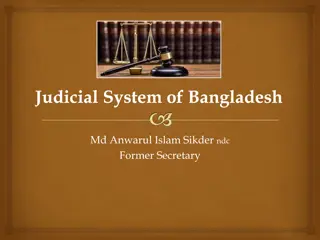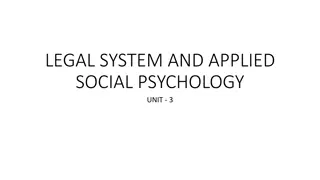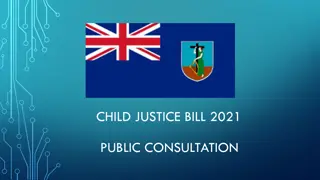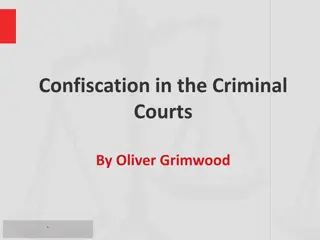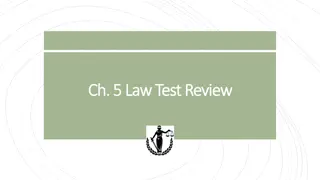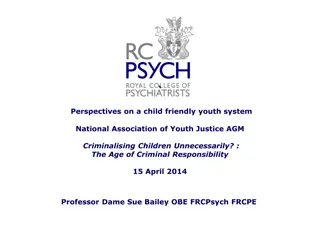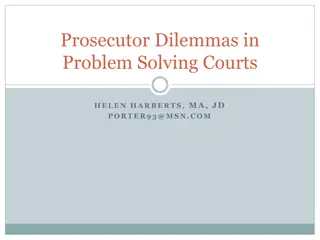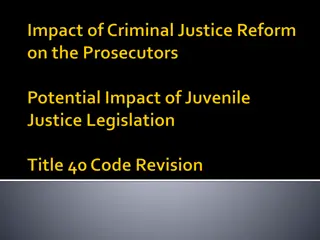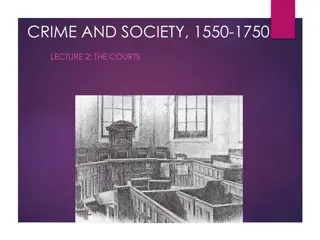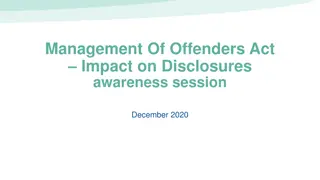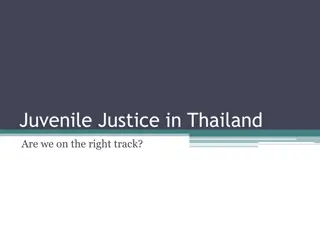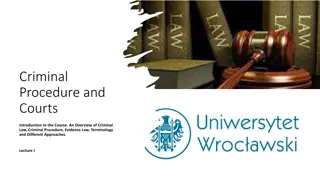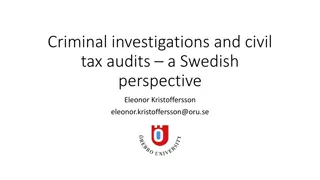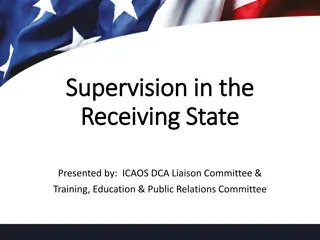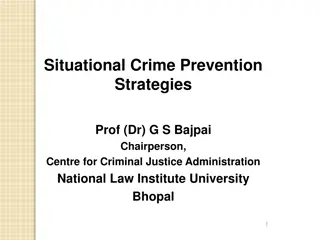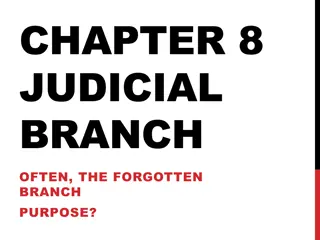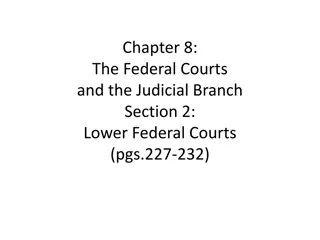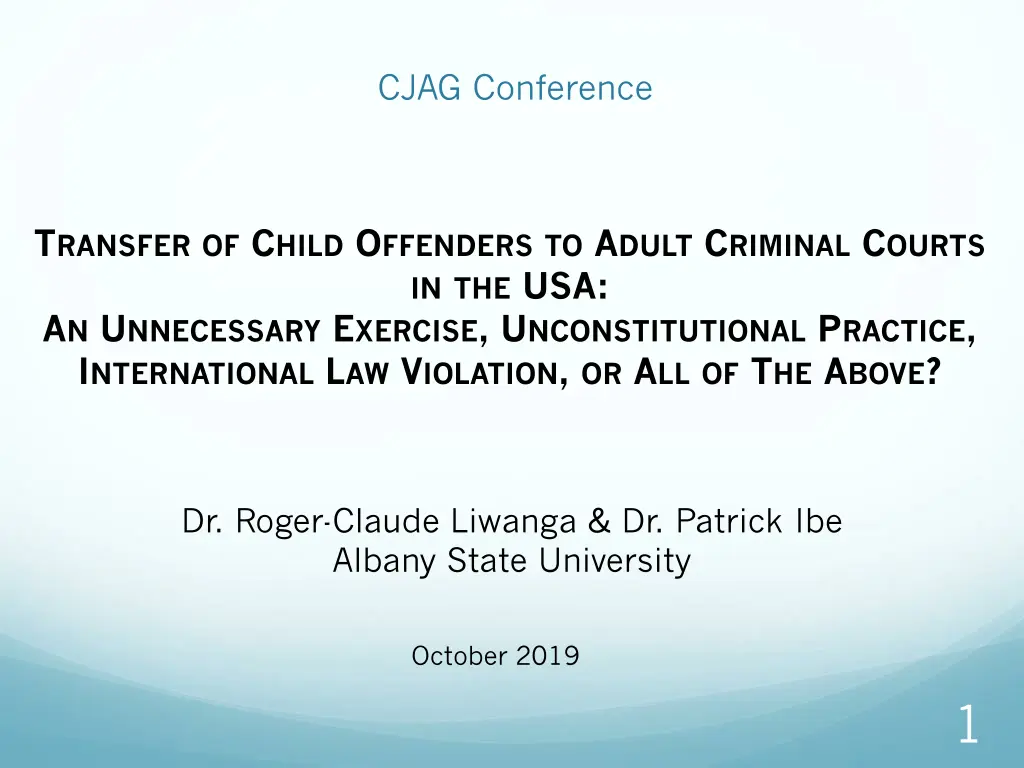
Debate on Transfer of Child Offenders to Adult Criminal Courts in the USA
Explore the legality and effectiveness of transferring child offenders to adult criminal courts in the USA. This presentation raises questions regarding the constitutional standards, compliance with international law, and the practice's impact on youth recidivism and juvenile violent crimes.
Download Presentation

Please find below an Image/Link to download the presentation.
The content on the website is provided AS IS for your information and personal use only. It may not be sold, licensed, or shared on other websites without obtaining consent from the author. If you encounter any issues during the download, it is possible that the publisher has removed the file from their server.
You are allowed to download the files provided on this website for personal or commercial use, subject to the condition that they are used lawfully. All files are the property of their respective owners.
The content on the website is provided AS IS for your information and personal use only. It may not be sold, licensed, or shared on other websites without obtaining consent from the author.
E N D
Presentation Transcript
CJAG Conference TRANSFEROF CHILD OFFENDERSTO ADULT CRIMINAL COURTS INTHE USA: AN UNNECESSARY EXERCISE, UNCONSTITUTIONAL PRACTICE, INTERNATIONAL LAW VIOLATION, OR ALLOF THE ABOVE? Dr. Roger-Claude Liwanga & Dr. Patrick Ibe Albany State University October 2019 1
Presentation Objectives All states within the U.S have laws authorizing judicial waiver or the transfer of child offenders to adult criminal courts for prosecution There is an ongoing debate over the legality and effectiveness of the use of judicial waiver as a tool against violent crimes committed by children in the U.S. The presentation seeks to answer a series of questions regarding judicial waiver: o Is the practice compliant with the U.S constitutional standards? o Is it a lawful practice under international instruments protecting children s rights? o Is it really an effective tool against youth recidivism and juvenile violent crimes? 2
Plan II. Analysis of the Constitutionality of the Transfer Laws in the U.S. I. Overview of the Concept of Judicial Waiver Judicial Waiver III. Legality of Judicial Waiver under International Law: Child Offenders' Right to be Tried by Juvenile Courts IV. Effectiveness of the Judicial Waiver Practice 3
I. Overview of the Concept of Judicial Waiver In the 1970s and 1980s: rise in the rate of juvenile violent crimes in the U.S. Most states adopted a get tough approach as a response against juvenile delinquency: Consisting of implementing the practice of judicial waiver A procedure in which child offenders are transferred from the juvenile court to the adult criminal court for prosecution and sentencing Today, all states within the U.S have judicial waiver laws 4
I. Overview of the Concept of Judicial Waiver (cont.) Who is a child? Who is a child concerned by judicial waiver? Each U.S. state determines who is qualified for the status of child under its criminal justice system Once a person is considered as an adult by the state court/law, he/she is no longer acknowledged as a child ( regardless of his/her age). In some U.S. states, the upper age of juvenile court jurisdiction over juvenile offense is 17 years old In other states, the common law set the minimum age for criminal responsibility at 7 years old, But many states specify the lower age of delinquency ranging from age 7 to age 14. 5
I. Overview of the Concept of Judicial Waiver (cont.) Who is a child? (cont.) International standards protecting children define a child as any person below 18 years of age. Article 1 of CRC (Convention on the Rights of the Child of 1989): A child means every human being below the age of eighteen years. Protections of the CRC are extended to every human being below the age of eighteen years. 6
I. Overview of the Concept of Judicial Waiver (cont.) What are the Characteristics of Judicial Waiver? 1. Age for Transfer o It is not identical across all U.S. states. o In most states, the age of transfer is 14 and older (e.g.: Kansas) o In Georgia, a child offenders of any age who commit any crime punishable by death or life imprisonment without parole, can be tried as adults (see: Code of Georgia, Sec. 15-11-5) 7
I. Overview of the Concept of Judicial Waiver (cont.) Characteristics of Judicial Waiver? (cont.) 2. Types of Crimes o Any criminal offense committed by a child of 14 or 15 (e.g.: Alabama, California, Tennessee, and Georgia. o Murder and capital crimes o Certain violent felonies (e.g.: nonnegligent manslaughter, forcible rape, robbery, and aggravated assault, and the property crimes of burglary, larceny-theft, and motor vehicle theft. o Certain drug offenses o Certain crimes committed by juveniles with prior records. Commonly, over 90% of juvenile transfers involved felonies rather than misdemeanors. (e.g.: Arizona, Florida & California) 8
I. Overview of the Concept of Judicial Waiver (cont.) Category of Transfer of Juveniles Laws in the U.S.? Can be categorized into four groups: o 1. Statutory exclusion or automatic transfer laws Some offenses (e.g.: murder, drug trafficking, weapons offenses, and other felonies) committed by children (16 -17 years) are automatically excluded from the jurisdiction of the juvenile courts. E.g.: S. Carolina, Illinois, Oregon o 2. Judicial-discretionary laws or judicially controlled transfer The juvenile courts decide if the child offenders must be sent to the adult criminal courts (after the prosecutors filing of the transfer motions). E.g.: Maine, Missouri, N. Carolina, N. Dakota, Tennessee, and Texas 9
I. Overview of the Concept of Judicial Waiver (cont.) Category of Transfer of Juveniles Laws in USA (cont.) o 3. Prosecutorial-discretionary or concurrent jurisdiction laws The prosecutor has the option of filing the charges against child offenders either before the juvenile court or the adult criminal court. E.g.: Colorado, Georgia, Florida, New York, DC, etc. o 4. Once-an adult-always-an-adult policies A juvenile, who was once tried in an adult criminal court, be considered as an adult offender if he/she recidivates, regardless of the seriousness or lightness of the present criminal offense 10
II. Constitutionality of Judicial Waiver in the U.S.? Kent v. United States (1967) Fact: The case concerned the 16-year-old Morris Kent, who resided in the District of Columbia (DC), and was detained and charged for burglary, robbery, and rape. Under the law, he was subject to the exclusive jurisdiction of the DC Juvenile Court unless it waives its jurisdiction. Kent s counsel filed a motion in the DC Juvenile Court for a hearing on the question of waiver and for access to the Juvenile Court s Social Service file that had been accumulated on Kent during his probation for a prior offense. But the Juvenile Court did not rule on these motions, and transferred Kent to the DC District Court to be tried as an adult. Issue: Was the juvenile court's waiver of jurisdiction valid? 11
II. Constitutionality of Judicial Waiver in the U.S.? (cont.) Kent v. United States (1967) Holding The U.S. Supreme Court held that the judicial waiver was invalid because the Juvenile Court failed to comply with the constitutional principle of due process. The Juvenile Court should hold a waiver hearing to determine whether Kent s case should be retained or transferred to adult criminal court. It set the criteria to be met to ascertain the constitutionality of a judicial waiver s process: 12
II. Constitutionality of Judicial Waiver in the U.S.? (cont.) Kent v. United States (1967) Holding (cont.) Criteria for the constitutionality of judicial waiver: 1. The seriousness of the criminal offense to the community 2. If the criminal offense was committed in an aggressive, violent, premeditated or willful manner 3. If the alleged offense was committed against persons or against property. 4. The prosecutive merit of the complaint 5. Sophistication of and maturity of the child offender 6. Record and previous history of delinquency 7. Prospects for adequate protection of the public and the likelihood of reasonable rehabilitation 13
II. Constitutionality of Judicial Waiver in the U.S.? (cont.) Breed v. Jones (1975) Facts: The 17-year-old Gary Jones was adjudicated by a Juvenile Court in California in 1971 for committing an act that, if committed by an adult, would constitute the crime of robbery in violation of California Penal Code. After a hearing at the Juvenile Court, the Court determined that Jones should be tried as an adult in California Superior Court. Jones filed a writ of habeas corpus and argued that the adult criminal trial put him in double jeopardy in violation of his rights under the Fifth and Fourteenth Amendments. successively denied by the Superior Court, the Court of Appeal, and the California Supreme Court. Jones was tried as an adult and found guilty of first-degree robbery. Jones s writ was 14
II. Constitutionality of Judicial Waiver in the U.S.? (cont.) Breed v. Jones (1975) Issue: Did a trial in adult criminal court after a trial in juvenile court for the same offense violate the double jeopardy clause? Holding: Yes. The prosecution of respondent in Superior Court, after an adjudicatory proceeding in Juvenile Court, violated the double jeopardy clause of the Fifth Amendment, as applied to the States through the Fourteenth Amendment. 15
Observations on the U.S. Supreme Court Rulings on Kent and Jones Cases? In both cases, the U.S. Supreme Court only ruled on the unconstitutionality of procedure applicable during judicial waiver rather than ruling on the constitutionality of the practice of judicial waiver itself. o The prohibition of double jeopardy in Jones case o Establishment of conditions for the constitutionality of the judicial waiver s process. Yet, the U.S. Supreme Court did not clarify if those conditions must be cumulatively met before the juvenile courts could waive their jurisdiction. In focusing only on the procedure of judicial waiver, the U.S. Supreme Court implicitly recognized the constitutionality of such a practice if the pre-established conditions are followed 16
III. Legality of Judicial Waiver under International Law? Children s Right to Juvenile Justice Article 40(2)(b)(iii) of the CRC (Convention on the Rights of the Child): Every child alleged as or accused of having infringed the penal law has at least the following guarantees: to have the matter determined without delay by a competent authority or judicial body in a fair hearing according to law. Article 14(1) of the ICCPR (International Covenant on Civil and Political Rights): Everyone shall be entitled to a fair and public hearing by a competent tribunal established by law. 17
III. Legality of Judicial Waiver under International Law? (cont.) Children s Right to Juvenile Justice (cont.) The CRC uses the term competent judicial body to refer to a juvenile court that is established and specialized to handle all offenses committed by persons under the age of 18 years. One s right to have his/her case adjudicated by a competent tribunal is a fundamental component of a fair trial. In the context of child offenders, the competent tribunal to hear their cases is the juvenile court. o This is irrespective of the gravity of the acts committed by the child offenders. 18
III. Legality of Judicial Waiver under International Law? (cont.) Juvenile Court as a Specialized and Rehabilitating Court Article 40(3) of the CRC: States parties shall seek to promote the establishment of laws, procedures, authorities and institutions specifically applicable to children alleged as, accused of, or recognized as having infringed the penal law. The juvenile justice should have two objectives: 1. Promoting the well-being of child offenders by emphasizing their rehabilitation rather than seeking merely punitive sanctions 2. Implementing the principle of proportionality. The response to the child offenders acts must not only consider the seriousness of their offenses, but also the individual circumstances of the offenders. 19
III. Legality of Judicial Waiver under International Law? (cont.) Juvenile Court as a Specialized and Rehabilitating Court (cont.) In Roper case (concerning the prohibition of death penalty against juveniles) and Miller case (concerning the abolition of mandatory life sentences without the possibility of parole against juveniles), the U.S. Supreme Court highlighted: o The difference between child offenders and adult criminals o Juveniles should not be classified among the worst offenders. Child offenders are less morally inexcusable than adults owing to: Their immaturity and irresponsibility; Their own vulnerability and lack of control that make them defenseless to escape the negative influences of society compared to adult offenders; Their irretrievably depraved character that is linked to their struggle in defining their own identity. 20
III. Legality of Judicial Waiver under International Law? (cont.) Children s Right to Juvenile Justice as Part of Customary International Law Of course, the US has not ratified the CRC Yet, one s right to have his/her case adjudicated by a competent tribunal is a component of the right to fair trial. The ICTY (International Criminal Tribunal for the former Yugoslavia) ruled that the right to a fair trial as guaranteed by Article 14 of the ICCPR was a requirement of customary international law. o See: In Prosecutor v. Aleksovski case (concerning the unlawful treatment of prisoners allegedly committed by the defendant during the Bosnian War) 21
III. Legality of Judicial Waiver under International Law? (cont.) Children s Right to Juvenile Justice as Part of Customary International Law (cont.) The practice of judicial waiver amounts to a violation of customary international law, as it deprives child offenders from their natural judges The particularity of customary international law is that its rules have erga omnes effects o This means that they should be enforceable by all countries that are part of the international community All nations including those who have ratified the CRC and the ICCPR and those who have not (such as, the U.S) are compelled to respect and enforce child offender s right to a competent and specialized court under any circumstances. 22
IV. Is judicial Waiver an Effective Deterrent Tool against Juvenile Delinquency? For the proponents of the judicial waiver, the practice would have: o Specific deterrent effects to the concerned child offenders against recidivism due to the severity of the punishment o General deterrent effects to future child offenders According to the National Center for Juvenile Justice, there were between 7,500 and 8,000 cases of judicial waivers across the country from 2000 to 2009. To evaluate the general deterrent of judicial waiver, we compare the % of all Arrests Involving Persons Under 18 in the State of Georgia, Idaho and Arizona 23
IV. Is judicial waiver an effective deterrent tool against juvenile delinquency? (cont.) A. Assessing the General Deterrent of Judicial Waiver Percent of All Arrests Involving Persons Under 18 in the State of Georgia: 2011-2014 Type of Crime 2011 2012 2013 2014 Robbery 19% 20.2% 22.2% 23% Motor Vehicle Theft 22.1% 24% 25.9% 28.4% Stolen Property 11.7% 13.2% 13.3% 12.9% Source: Adapted from Puzzanchera & Kang, Easy Access to FBI Arrest Statistics 1994-2014 24
IV. Is Judicial Waiver an Effective Deterrent Tool against Juvenile Delinquency? (cont.) A. Assessing the General Deterrent of Judicial Waiver (cont.) Percent of All Arrests Involving Persons Under 18 in the State of Idaho: 2011-2014 Type of Crime 2011 2012 2013 2014 Robbery 12.6% 17% 11.9% 11% Motor Vehicle Theft 38.2% 36.7% 42.2% 39.5% Stolen Property 19.4% 21% 12.5% 15.2% Source: Adapted from Puzzanchera & Kang, Easy Access to FBI Arrest Statistics 1994-2014 25
IV. Is Judicial Waiver an Effective Deterrent Tool against Juvenile Delinquency? A. Assessing the General Deterrent of Judicial Waiver (cont.) Percent of All Arrests Involving Persons Under 18 in the State of Arizona: 2011-2014 Type of Crime Robbery 2011 15.1% 2012 15.2% 2013 14.8% 2014 13.8% Motor Vehicle Theft 20.8% 18.5% 18.8% 17.7% Stolen Property 9.9% 7.9% 7.2% 7% Source: Adapted from Puzzanchera & Kang, Easy Access to FBI Arrest Statistics 1994-2014 26
Findings on Assessing the General Deterrent of Judicial Waive In Idaho: In GA, there is an increase of the % of juvenile arrests: For robbery: An increase from 19% in 2011 to 23% in 2014. For motor vehicle theft: An increase from 22.1% in 2011 to 28.4% in 2014 For stolen property crime: An increase from 11.7% in 2011 to 12.9% in 2014. There is an increase of the % of juvenile arrests for robbery from 12% in 2011 to 19% in 2012 before decreasing to 11% in 2014. For motor vehicle theft: An increase from 38% in 2011 to 39.5 in 2014 For stolen property crime: An increase from 19% in 2011 to 21% in 2012 before decreasing to 15% in 2014. In Arizona, there is a slight decline of the % of juvenile arrests: For robbery: A decrease from 15.1% in 2011 to 13.8% in 2014 2014. For motor vehicle theft: A decrease from 20.8% in 2011 to 17.7% in 2014 For stolen property crime: A decrease from 9.9 % in 2011 to 7% in 2014
IV. Is Judicial Waiver an Effective Deterrent Tool against Juvenile Delinquency? (cont.) B. Assessing the Specific Deterrent of Judicial Waiver In 2005, Lanza-Kaduce examined the recidivism rates of child offenders who were transferred to the adult criminal court and those whose cases were adjudicated at the juvenile court. The study concerned 950 child offenders in Florida, of whom 475 were transferred to the criminal court in 1995 and 1996. And the other 475 remained in the juvenile system. See: Lonn Lanza-Kaduce et al, Juvenile Offenders and Adult Felony Recidivism: The Impact of Transfer, 28 Journal of Crime and Justice (2005):59 77. 28
B. Assessing the Specific Deterrent of Judicial Waiver Findings of Lanza-Kaduce s research: o Child offenders who were transferred to adult criminal court were significantly more likely to reoffend. o Approximately 49% of the transferred child offenders reoffended, compared with 35% of child offenders retained by the juvenile court. o Regarding the commission of violent offenses, the survey disclosed that 24% of the transferred child offenders reoffended, compared with 16% of child offenders retained by the juvenile court. o The rate of recidivisms for drug offenses was 11% for the transferred child offenders and 9% for child offenders retained by the juvenile court; Whereas for property offenses, the rates were 14% for transferred child offenders versus 10% for retained child offenders. 29
Conclusion Judicial waiver is an ineffective practice: o Its deterrent virtue against youth recidivism and juvenile violent crimes is unproven. o Recidivism rates are lower for child offenders tried in juvenile court than for those who are transferred to adult criminal court. The right to a competent court is one of the components of the right to a fair trial. It is also part of the customary international law that should be enforced by all nations (including the USA). Recommendations: o Restoration of the full jurisdiction of the juvenile court over all child offenses o Reversal of the judicial waiver laws because of their failure of ensuring children s right to a competent and specialized system. 30
Thank You 31

